A behavioural inquiry
Gaze and movement behaviour around colossal figurative statues
This inquiry into the affordances of a figurative colossal statue was done to inform a pure mixed reality experience design for a HoloLens museum guide. The 3.9 m tall sculpture representing the goddess of victory - Victoria - was made by the Fritz Schaper in 1885 and is now located in the entrance hall of the Deutsches Historisches Museum (DHM) in Berlin.
Modes of looking

To understand how visitors look at a figurative clolossal statue, we formulated two tasks to complete while wearing the HoloLens. The idea here is, to understand the different modes of looking (beholding) to inform the interaction design for selecting the additional content which will be created to augment the statue with more information.
Mainly there are two modes. (1) Looking as a reaction of a stimulus or (2) actively seeking for information. Hence, the task for the study subjects were:
- (Task 1) Goal oriented viewing task: „Examine the Victoria with detail. You have as much time as you need. When you come back I will ask you questions about the statue. So try to memorize as much detail as possible, this is the only way you can answer the following questions.“
- (Task 2) Explorative viewing task: „We are testing the ergonomics of the HoloLens. There is not much to see yet, just a cursor. Please have a try and examine the Victoria with it. You have as much time as you wish.“
The study was conducted on two days with a prior pilot study to make sure the study artefacts work as intended. In total 21 subjects participated (7 female, 14 male) of which 66% visited the DHM the first time. 48% of them were wearing glasses, 43% did not need any a aid, 9% not determined. Nobody had prior experience in using a HoloLens, 42.86% used a VR system before and 57.14% used an AR-App before. 38.1% of the subjects had no prior experience with a Mixed Reality Application.
The average task completion time of the goal oriented Task 1 was double the time of Task 2 (1:07 minutes).
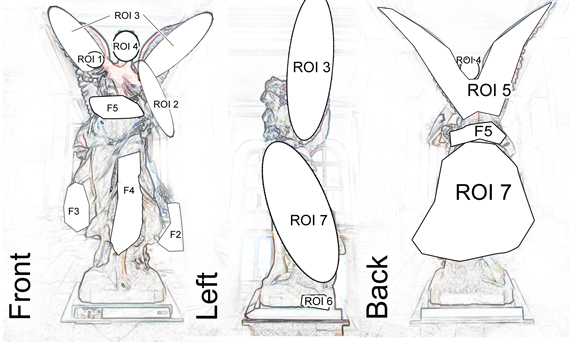
The average ammount of fixations (definition of fixation cf. Joos et al. [1]) done by a subject was 21.64 FpP for Task 1 and 15 FpP for Task 2. Both, total time for completion and average ammount of fixations indicate the task description has an impact on the thoroughness of observing. In Task 1 a more thorough beholding behaviour was observed.
| Task 1 | Task 2 | |
|---|---|---|
| Robe total (incl. F4, F3, F2, F5 and ROI7) | 36.96% | 36% |
| F2 | 6.72% | 7.33% |
| F3 | 6.72% | 4.67% |
| Left knee (F4) | 7.14% | 6% |
| F5 | 11.76% | 10% |
| Head (ROI 4) | 9.66% | 10.67% |
| Missing Arm (ROI 1) | 7.14% | 7.33% |
| Wings (ROI 3) | 13.03% | 14.67% |
| Palmtree branch (ROI 2) | 6.3% | 0% |
| Left sandal | 5.46% | 0% |
| Left bosom | 0% | 4.67% |
| Inscription of name and year (ROI 6) | 0% | 0% |
| Total fixations counted (def. [1]) | 238 | 150 |
Circulation
There is no right-turn bias [2] as the objects affordance seems to overwrite this bias. In the pilot test (n=5) we started from the left side of Victoria to see whether such a right-turn bias would exist. All subjects went to the front first. For day 1 of the full study the starting point was shifted to the right side of the sculpture to compare the data with the pilots data. Again, all subjects (n=9) went to the front. On day 2 of the full study we again shifted the starting point to the left as we needed more data to confirm the missing right-turn bias (n=12). No surpises here subjects went to the front first.
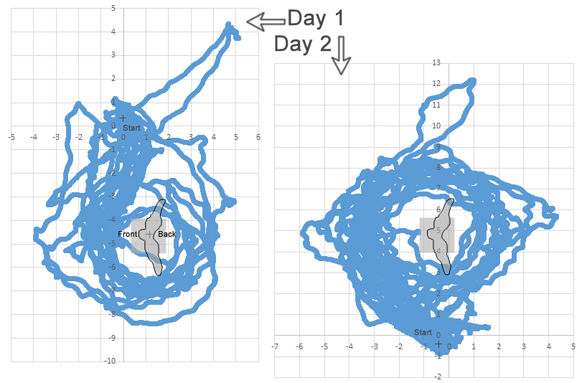
However, there is some interesting phenomena to recognize about circulation, when position samples (here 20 per second) are subsampled in areas of 1m². Viewers seem to spend more time at the beginning of their trail than at the end. We can see that when looking at heatmap. In both cases, wheter people start from the right or the left, there are less samples to count per m² at the end of the trail.
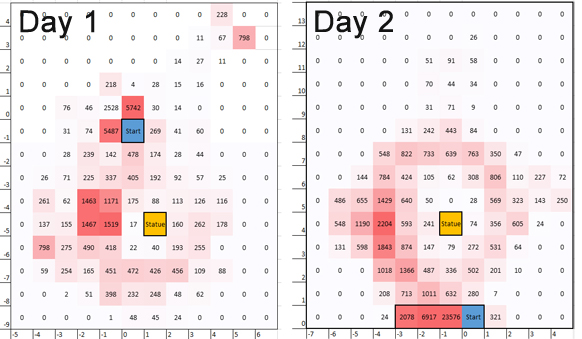
Description here ...
Vistas of attention and interest
Area of Focus <- attention, Area of Interest <- users areas of interest Subsapled from 20 samples per second we can calculate the "hang time" stops + walking
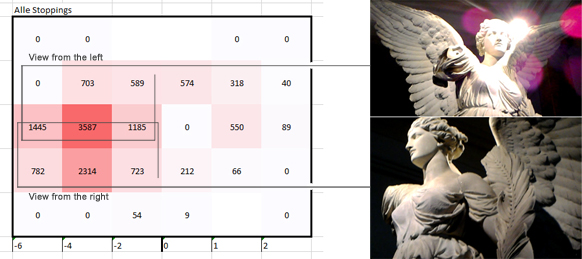
The diagram below show the stops calculated from the log file, in contrast to the subsampled trails above. Each colour indicates a stopping position of a subject. On average users assigned to Task 1 stopped 5 times and users doing Task 2 stopped 3.7 times. Changing distance to the statue was in Task 1 on average 1.81 and for Task 2 0.7.
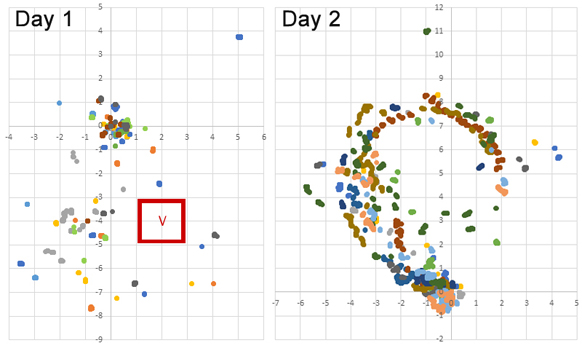
The diagram below shows the distribution of stops from reviewing the video and counting true stops in contrast to using the mean abode time from the positioning coordinates of the log data. In total 85 stops were counted created by 20 subjects. One subject was an outlier and was not counted as the movement was very slow but never stopping as defined (planting both feet next to each other).
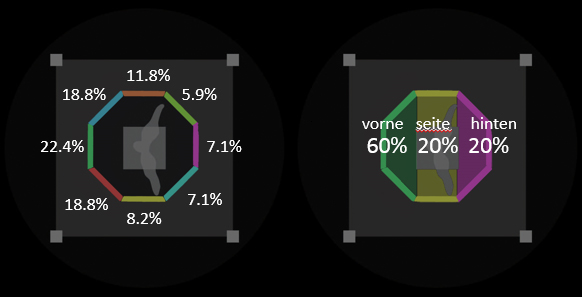
Interesting to see is also the impact of the task when task completion time is plottet against completeness of beholding. In the scattergram below each mark is a subject (blue = task 1, red = task 2). You can see the average completion time for Task 1 was double of Task 2 and subjects reached a higher degree of completeness. The task caused them to be more thorough.
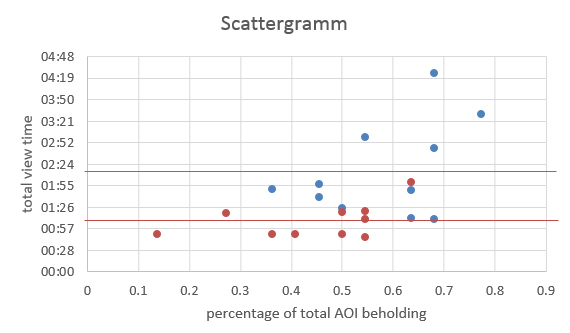
Questionnaires
The formulation of the task had also an impact on the answeres in the questionnaire.
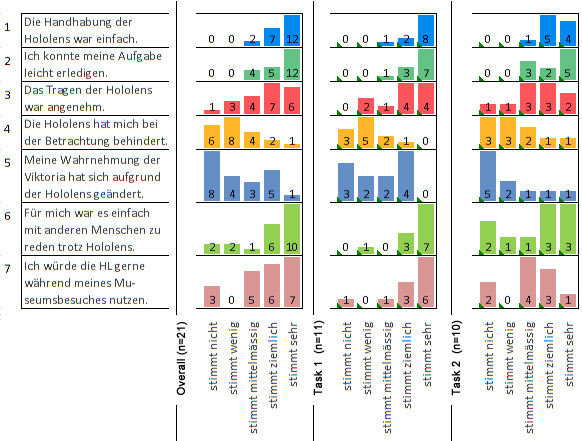
References:
[1] Joos, M.; Rötting, M. u. Velichkovsky, B.M.(2008): Bewegungen des menschlichen Auges: Fakten, Methoden und innovative Anwendungen. In: Psycholinguistik.: Ein internationales Handbuch. 142ff, Berlin.
[2] Melton, A.W. (1935). Problems of installation in museums of art (New Series No. 14).Washington, DC: American Association of Museums.
Co-Producer:
museum4punkt0
Katrin Glinka (Production)
Dr. Silke Krohn (Production)
Deutsches Historisches Museum
Elisabeth Breitkopf-Bruckschen (Production)
Stiftung Preußischer Kulturbesitz
Team:
Freie Universität Berlin
Dr. Patrick Tobias Fischer (Research and Development)
Prof. Dr. rer. nat. Claudia Müller-Birn (Research)
Framefield GmbH
Thomas Mann (CEO)
Dominik Ganghofer (Unity Developer)
Unity Code:
GitLab
Externer Link:
Projektwebseite





